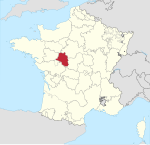Saint-Cyr-sur-Loire
Communes of Indre-et-LoireIndre-et-Loire geography stubsPages including recorded pronunciationsPages with French IPAPages with disabled graphs

Saint-Cyr-sur-Loire (French pronunciation: [sɛ̃ siʁ syʁ lwaʁ] , literally Saint-Cyr on Loire) is a commune in the department of Indre-et-Loire in central France.It is located northwest of Tours on the other side of the Loire. It is the third largest city in the Indre-et-Loire department, behind Tours and Joué-lès-Tours.
Excerpt from the Wikipedia article Saint-Cyr-sur-Loire (License: CC BY-SA 3.0, Authors, Images).Saint-Cyr-sur-Loire
La Peraudière, Tours
Geographical coordinates (GPS) Address Website Nearby Places Show on map
Geographical coordinates (GPS)
| Latitude | Longitude |
|---|---|
| N 47.399015 ° | E 0.667328 ° |
Address
Hôtel de Ville
La Peraudière
37540 Tours
Centre-Val de Loire, France
Open on Google Maps









